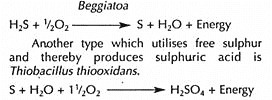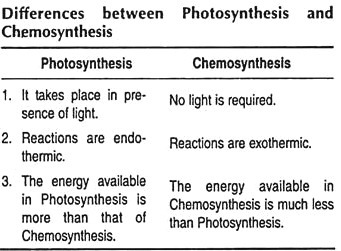ADVERTISEMENTS:
In this article we will discuss about nutrition and growth in bacteria.
Nutrition in Bacteria:
Bacteria are devoid of chlorophyll and they perform heterotrophic mode of nutrition.
However, there is a small group of bacteria which are autotrophic:
1. Autotrophic Bacteria:
ADVERTISEMENTS:
They can synthesise carbohydrate .food from CO2 like that of chlorophyll containing plants. They are of two types: Photosynthetic bacteria or photosynthetic autotrophs and chemosynthetic bacteria or non-photosynthetic autotrophs.
(a) Photosynthetic autotrophs:
They can build the carbohydrate in presence of sunlight taking carbon from carbon- dioxide. They grow in light and are commonly found in sulphur springs where hydrogen sulphide is commonly available as electron donor.
They are of the following types:
ADVERTISEMENTS:
(i) Green sulphur bacteria:
They are strictly anaerobic photoautotrophs. Their photosynthetic pigment, chlorobium chlorophyll, is located in the invagination of plasma membrane towards the cytoplasm. These bacteria use hydrogen sulphide (H2S) or other reduced inorganic sulphur compounds as the donor of hydrogen. Light splits H2S, and forms hydrogen which combines with CO2 to form CH2O. Sulphur is excreted out and deposited extra- cellularly, e.g., Chlorobium, Pelodictyon etc.
The overall reaction is:
(ii) Purple sulphur bacteria:
They are anaerobes and the photosynthetic pigment bacteriochlorophyli is located in the invagination of plasma membrane. The H2S is oxidised anaerobically via elemental sulphur to sulphate. The by-product sulphur is stored in the cell as globules, except Ectothiorhodospira, where sulpnur is excreted out like green sulphur bacteria, e.g., Thiocystis, Thiocapsa, Thiospirillum, Rhodospirillum etc.
The overall reaction is:
In addition to above, some sulphur bacteria can use other sulphur compounds like sulphite, thiosulphate etc., instead of H2S.
ADVERTISEMENTS:
(iii) Other two groups of photosynthetic autotrophs such as non-sulphur purple and brown bacteria are grown in stagnant water and mud. They have bacteriochlorophyli as photosynthetic pigment. They use organic acid like malic acid, propionic acid etc. as hydrogen donor and light as the source of energy.
The overall reactions are:
e.g., Rhodospirillum, Rhodomicrobium, Rhodopseudomonas etc.
ADVERTISEMENTS:
(b) Chemosynthetic autotrophs:
Chemosynthetic bacteria are more abundant in nature than that of photosynthetic bacteria. They are non-photosynthetic and for synthesis of food they get energy by the oxidation of certain inorganic substances such as nitrates, nitrites, ferrous compound, hydrogen sulphide and many other metallic or non-metallic substances.
The bacteria absorb inorganic molecules in their body where energy is released by breaking down of chemical bonds of the molecules. This energy is used to combine CO2 and water into food molecules. This process is called chemosynthesis. It is an exothermic reaction. This group of bacteria is independent of light and organic material.
Depending on the substrate specificity, they are of the following types:
ADVERTISEMENTS:
(i) Sulphur bacteria:
These bacteria oxidise sulphur compounds, thus energy being released and is utilised for food synthesis.
The sulphur remains as granular residue in the bacterial cytoplasm, e.g., Beggiatoa:
(ii) Iron bacteria:
ADVERTISEMENTS:
These bacteria oxidise ferrous compounds into ferric form and liberate energy. The energy is utilised in the synthesis of organic compounds, e.g., Gallionella, Leptothrix etc.
Fe2+ ——————-> Fe3+ + e–
The ferric iron being deposited as insoluble ferric hydroxide is mentioned below:
2Fe(HCO3)2 + O + H2O —> 2Fe(OH)3 + 4CO2 + Energy
(iii) Nitrifying bacteria:
ADVERTISEMENTS:
This group of bacteria helps in increasing the nitrogen source in nature. They oxidise ammonia to nitrate in two steps: ammonia to nitrous acid and nitrous acid to nitric acid, in which acids react with metal ions to produce the corresponding salts, i.e., nitrite and nitrate. The steps are bacteria specific.
The first step involves the oxidation of ammonia to nitrous acid by nitrosifying bacteria like Nitrosomonas, Nitro- coccus and Nitrospira is called nitrosification. The process is catalysing by the enzyme, ammonia dehydrogenase. The second step involves oxidation of nitrous acid to nitric acid by Nitrobacter, Nitrococcus and Nitrospira is called nitrification. The reaction is carrying out by nitrous acid dehydrogenase enzyme.
Step-I : 2NH4+ + 30,———> 2NOf + 4H+ + 2H2O
Step-II : 2NO2 + O2 ———–> 2NO–3
(iv) Hydrogen bacteria:
This group of bacteria oxidises molecular hydrogen and produces water and energy, e.g., Pseudomonas facilis, Nocardia opaca, Alcaligenes eutrophs.
ADVERTISEMENTS:
H2 + ½O2——–> H2O
2. Heterotrophic Bacteria:
These bacteria obtain their food from any organic source.
They are of two types:
a. Saprophytic, and
b. Parasitic.
(a) Saprophytic (Saprobic) bacteria:
These bacteria grow on decaying organic matters and live by digesting and absorbing them. By secreting enzymes -they break complex organic compound into simpler forms. These simpler forms are rendered into soluble form and are absorbed by the bacteria as food.
The breakdown of compounds may be of two types:
(i) Fermentation, and
(ii) Putrefaction.
(i) Fermentation:
The breakdown of carbohydrate is known as fermentation. Some bacteria (Escherichia coli) are able to ferment glucose and galactose, thereby CO2 is released. On the other hand, some bacteria like Lactobacillus ferment milk and produce an organic acid, the lactic acid which causes the souring and curding of milk. Carbon dioxide is not evolved in this process.
(ii) Putrefaction:
The breakdown of protein material is known as putrefaction. The earlier stage takes place in absence of oxygen by some anaerobic bacteria, where peptone, peptide, polypeptide and amino acids are produced. Some of the substances have unpleasant odour. The later stages of breakdown require oxygen where substances like amino acids are further decomposed into sulphur substance such as methane, nitrogen, hydrogen, ammonia etc. A few species are able to degrade fats into fatty acids and glycerine.
(b) Parasitic bacteria:
They grow on or within living organisms like plants and animals. They draw the organic food from their host. These are of two types: Symbiotic and Pathogenic:
(i) Symbiotic bacteria:
These bacteria are useful to the host on one hand and receive food and shelter in return. Different types of coli bacteria are inhabiting the intestine of man and other organisms, which help in the digestion of cellulose by various enzymes secreted by them.
These bacteria also deposit vitamins which can be used by the host. In return they take shelter and food from the host. In leguminous plants, the bacterium Rhizobium develops root nodules. The Rhizobium possesses nitrogenase enzyme and thus can fix atmospheric nitrogen useful to the plants and, in return, it also takes shelter and food from its host. Frankia spp. of Actinomyceteous fungi develop root nodules in about 178 species of non-leguminous plants like Casuarina, Alnus, Myrica; Elaeagnus, Coriaria, Ceanothus etc. They also fix atmospheric N2 with the help of nitrogenase enzyme.
(ii) Pathogenic bacteria:
These bacteria cause diseases of plants and animals including man. They cause diseases on the host either by direct attack or by liberation of toxic substances which affect directly or indirectly. Some common human diseases caused by pathogenic bacteria are Cholera (Vibrio cholerae), Diphtheria (Corynebacterium diphtheriae), Tuberculosis (Mycobacterium tuberculosis), Typhoid (Salmonella typhi), Pneumonia (Mycoplasma pneumoniae) etc.
The plant diseases caused by bacteria are citrus canker (Xanthomonas axonopodis pv. citri), Bacterial blight of rice (Xanthomonas campestris pv. oryzae), Tundu disease of wheat (Clavibacter triticiBacterial blight of cotton (Xanthomonas malvacearum), etc.
Growth of Bacteria:
The growth of bacteria requires proper nutrition and proper environment:
1. Requirement of Nutrition:
The nutrition includes essential elements, mineral sources and organic growth factors.
(a) Essential elements:
The essential elements required for the synthesis of structural compounds such as nucleic acid, protein, fat and carbohydrate are carbon, nitrogen, hydrogen and oxygen. In addition to the above elements, sulphur and phosphorus are also required for bacterial growth. These elements have to be supplied in the medium for proper growth.
(b) Mineral sources:
The minerals such as calcium, magnesium, potassium, iron, cobalt, Copper, manganese, zinc and molybdenum are required as trace elements for the function of different enzymes.
(c) Organic growth factors:
Some bacteria require, organic compounds for their growth and these are called growth factors or vitamins. These are required at micro-level as essential (required for their growth) factor or accessory (required for enhancing growth) factor.
Requirement of Proper Environment:
ADVERTISEMENTS:
The environmental factors like water, oxygen, carbon dioxide, light, temperature, pH and osmotic pressure are essential for the growth of bacteria.
(a) Water:
Water is an essential requirement for growth, because approximately 80% of the cell volume consists of water.
(b) Oxygen:
The bacteria differ in the requirement of oxygen. They are of two types: aerobes and anaerobes. The aerobes require oxygen for growth. The aerobes again can be divided into obligate (e.g., Pseudomonas) or facultative anaerobes i.e., they are normally aerobes, but can grow without oxygen (e.g., Vibrio cholerae). The anaerobes do not require oxygen for their growth and they may die in presence of oxygen (e.g., Clostridium).
(c) CO2:
Very small amount of CO2 is required for all bacteria which may be available endogenously or may be collected from atmosphere.
(d) Temperature:
Temperature is essential for growth, but optimum temperature for growth varies with different bacterial species. Bacteria may be grouped as Psychrophile (grows below 20°C), Mesophile (grows between 25-40°C) and Thermophile (grows between 55-88°C).
(e) pH:
Most of the bacteria associated with human diseases require 7.2-7.4 pH, but Vibrio cholerae requires 10.5 pH. Bacteria like Lactobacillus and Thiobacillus thioxidans require 3.0 pH for their growth.
(f) Light:
Bacteria generally prefer to grow in dark, but some phototropic species grow in light.
(g) Osmotic pressure:
Bacteria are able to grow in a wide range of osmotic pressure, because of rigid and tough cell wall.



